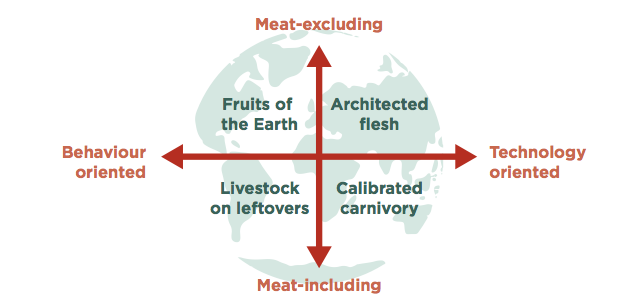Is cultured meat one of the “four futures?”
In a new article the Food Climate Research Network (FCRN) has developed a look at what various groups consider the “meat problem”, and from there developed four extreme scenarios about the future of meat.
The issues they identified were a higher demand for food, the environmental cost of meat, the interest of sellers to maximize sales, the ideological and religious arguments for a certain diet, the price of meat, the health benefits and detriments, and the various implications for class strucutre.
Among the four futures they predicted was the “Architected Flesh” scenario. It’s 2035, and after plagues of zoonotic (livestock-born) diseases and rising costs of meat, governments and consumers start to support mimic meats and milk. In this future, big business follows suit, and the call for cultured meat is raised. As more countries support cultured meat, the environment recovers, food restrictions based on religion are no longer an issue, and health goes up as meat is made healthier. Meanwhile, better quality cultured meat becomes more available across all income levels.
The other futures include Calibrated Carnivory, Livestock on Leftovers, and Fruits of the Earth.
Calibrated Carnivory is concerned with the demand for food, and the demand for sustainability. In this future, GMOs, antibiotics, hormones, and cramped living conditions are used to decrease the amount of feed, and increase the amount of meat on each animal. Waste products are used as fertilizer and heating. This future can be defined as “market driven” as chicken and fish are the easiest to raise in cramped conditions, and the easiest to sell as diet foods. While some people in the future care about the animals’ rights, they are convinced to withhold their complaints because the price of meat decreases.
Livestock on Leftovers’ main concern is big business and a return to “the past.” This future follows a paleo-style diet. Cities are forsaken with for small farms, where animals are raised on non-arable pastures, eating inedible grasses, and manure is used as fertilizer for crops. Hunting is also popular. However, FCRN points out the inevitable problem with this model: as population grows, small farms do not produce enough meat or milk to meet the demand, and a return to large industrial farms is inevitable. Although the FCRN avoided mentioning it, “Livestock on Leftovers” is likely to lead straight into “Calibrated Carnivory.”
The fourth future that the FCRN projected is one based on environmental impacts, and a government push for vegetarianism as a more sustainable method of feeding the world. Meat is a rarity, and livestock are kept only in nonarable plots, or places where their manure helps the harvest. The land once used to grow food for livestock is now optimized to grow crops for human On this diet, the FCRN predicts better eating habits and health, but this future is rife with anxiety over the “ecological price” of food.
So which future do you want? Or is there another option?
The article’s purpose is not to give consumers four options for the future. The purpose is to identify the “issues with meat” and then demonstrate how different concerns lead to different outcomes. Sustainability, supply and demand, humanitarianism. The future will be shaped by what we choose to focus on.
Want to know more about how our top priorities shape the future?
Download the article pdf here.


